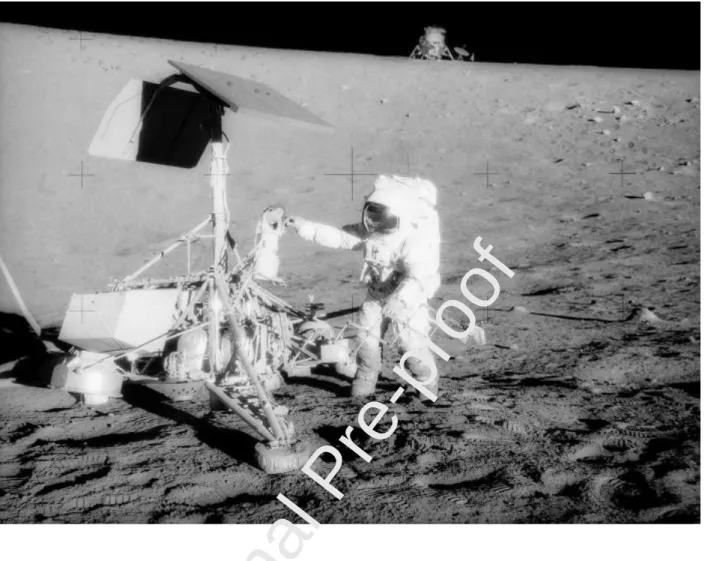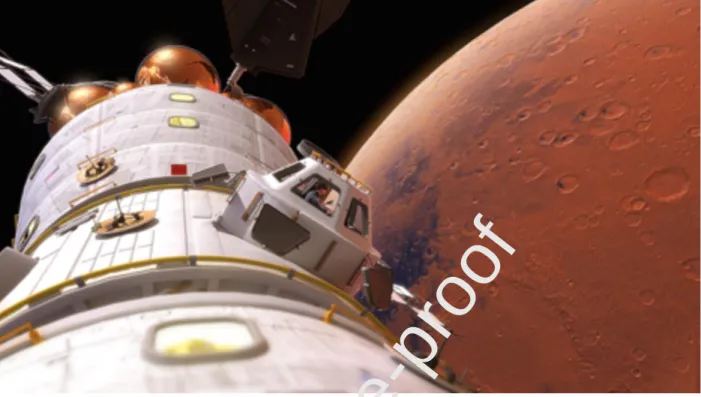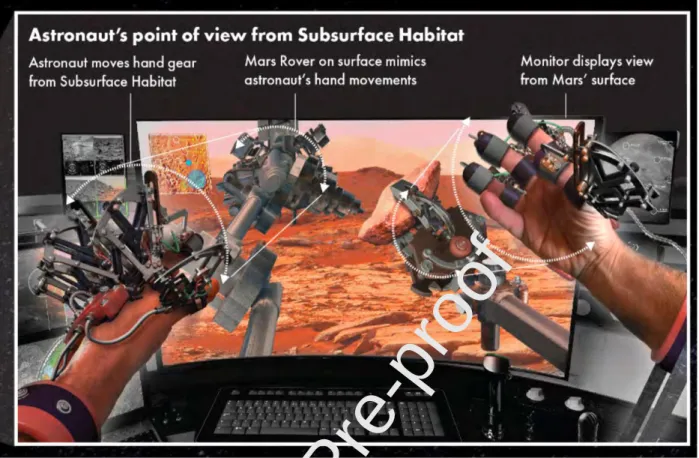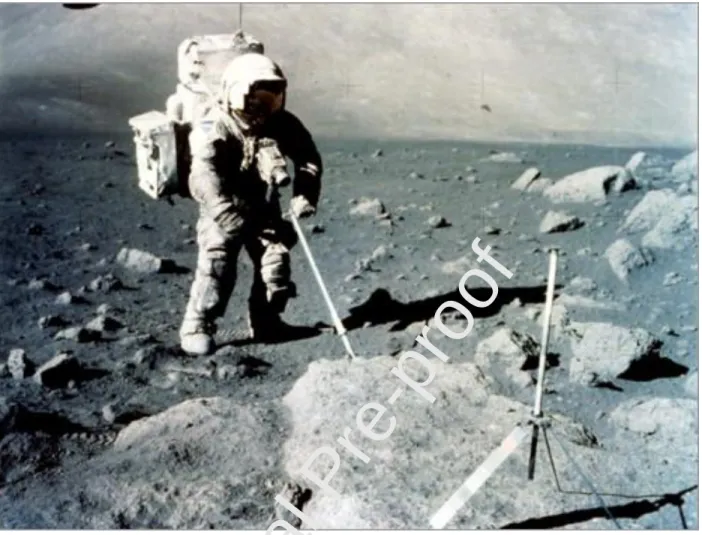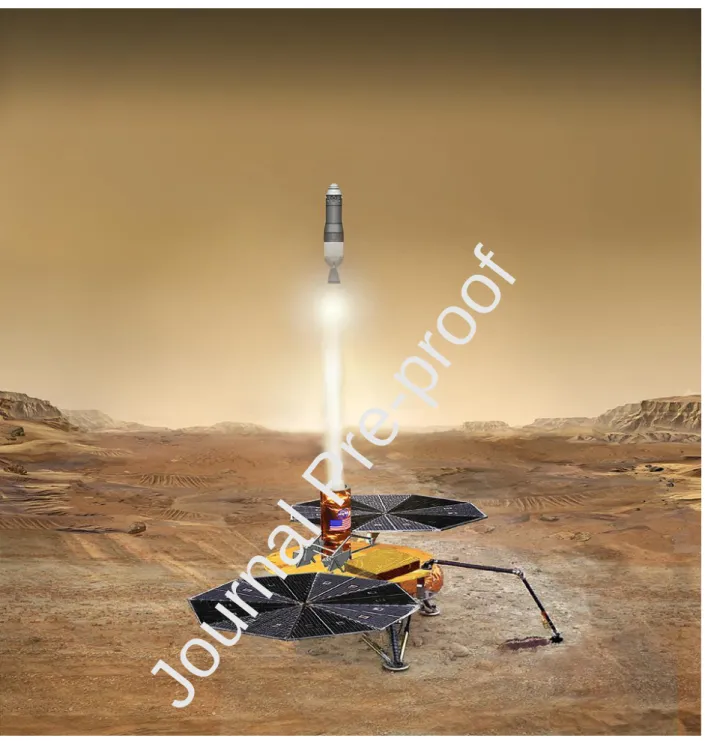Next frontier in planetary geological reconnaissance: Low-latency telepresence
Robert C. Anderson, Dan Adamo, Debra Buczkowski, James Dohm, Tamas Haidegger, Tom Jones, Gregg Podnar, Daniellle Wyrick
PII: S0019-1035(21)00230-X
DOI: https://doi.org/10.1016/j.icarus.2021.114558
Reference: YICAR 114558
To appear in: Icarus
Received date: 13 March 2021 Revised date: 15 May 2021 Accepted date: 24 May 2021
Please cite this article as: R.C. Anderson, D. Adamo, D. Buczkowski, et al., Next frontier in planetary geological reconnaissance: Low-latency telepresence, Icarus (2018), https://doi.org/10.1016/j.icarus.2021.114558
This is a PDF file of an article that has undergone enhancements after acceptance, such as the addition of a cover page and metadata, and formatting for readability, but it is not yet the definitive version of record. This version will undergo additional copyediting, typesetting and review before it is published in its final form, but we are providing this version to give early visibility of the article. Please note that, during the production process, errors may be discovered which could affect the content, and all legal disclaimers that apply to the journal pertain.
© 2018 © 2021 Published by Elsevier Inc.
Next Frontier in Planetary Geological Reconnaissance: Low-Latency Telepresence
Robert C. Andersona,* robert.c.anderson@jpl.nasa.gov, Dan Adamob, Debra Buczkowskic, James Dohmd, Tamas Haideggere, Tom Jonesf, Gregg Podnarg, Daniellle Wyrickh
aJet Propulsion Laboratory/California Institute of Technology
bIndependent Astrodynamics Consultant
cApplied Physics Laboratory
dExploration Institute
eUniversity Research and Innovation Center (EKIK), Obuda University
fFlorida Institute for Human and Machine Cognition
gAeolus Robotics
hSouthwest Research
*Corresponding author.
ABSTRACT
The most compelling questions about the possibility of life on other planetary bodies will likely be answered only once the human mind can fully engage with the explored alien surface. Current interplanetary science operation models are primarily based on the paradigm of using robotic off- Earth assets for exploration. Conducting field geology research on other planetary bodies requires experts to use data collected from advanced technologies to substitute for their on-site presence to overcome the time delay (e.g., latency) and bandwidth constraints in the transfer of data. To overcome these constraints, astronauts will need to be placed either directly on the surface (e.g., “boots on the ground”) or robotic systems will need to be deployed and directed by humans from Earth with massive time delays. In the next major stage of planetary reconnaissance, as presented here, deployment of teleoperated robotic assets with humans sufficiently proximal to the exploration targets (referred to here as “Low-Latency Telepresence (LLT)”) will greatly enhance scientific return. Humans in orbit can be present electronically/digitally at multiple sites on a planetary surface, and that presence can be sterile, alleviating planetary protection concerns. Crewed astronauts using LLT, in partnership with robotic agents on the surface, will provide scientists the means to explore, for example, the mountains and vast canyon systems on Mars and the submarine environment of Jupiter’s moon
Journal Pre-proof
Europa. Consequently, because LLT does not require humans to be physically present at the exploration site, it is potentially advantageous in terms of schedule and cost, reduces human and planetary risks, while increasing the quantity and quality of the science data that can be returned.
Keywords Low-Latency robotics telepresence
1.0 INTRODUCTION
Current interplanetary science operation models are primarily based on the paradigm of using robotic off-Earth assets for exploration. Conducting field geology research on other planetary bodies requires experts to use data collected from advanced technologies to substitute for their on-site presence. While this process enables Earthbound scientists to acquire measurements and conduct experiments, time delays between commands sent from Earth, the data collected in space, and reception of those data on Earth, severely inhibit interaction and productivity, and poses a great operational risk. Consequently, the quantity and quality of the science data that can be returned are greatly reduced. The ability to do hands-on field research across a diversity of rock types is limited because geologists cannot attain real-time interaction and reaction with the landscape. Thus, Low-Latency Telepresence (LLT) is considered here as the necessary next major stage in planetary reconnaissance.
Since the end of Apollo human missions to the lunar surface, planetary exploration has been exclusively conducted using teleprogrammed robots. For example, field geology is currently conducted on Mars by collecting data from remote orbiting probes and multi-instrumented surface landers and rovers. Despite the proven successes of in-situ science by the Mars Exploration Rovers (Spirit and Opportunity) and the Mars Science Laboratory (Curiosity) rover
Journal Pre-proof
on the surface of Mars, new standards for exploration are required to study distant planetary bodies in the solar system at greater depth and productivity. Numerous strategies have been suggested and initiated to overcome the latency and bandwidth constraints imposed by the great distances from the Earth: 1) placement of scientists/astronauts directly on planetary surfaces, as was done in the Apollo era; 2) development of fully-autonomous robotic systems capable of conducting in-situ field science research; or 3) deployment of teleoperated robotic assets with humans sufficiently proximal to the exploration targets, thereby achieving effective human telepresence (Keck Institute for Space Studies (KISS) workshops;
https://kiss.caltech.edu/workshops/telepresence/telepresence.html). The significance and effectiveness of the third strategy in planetary reconnaissance, at least as an important intermediate step before having boots on an extraterrestrial surface, which includes feasibility and deployability of low-latency telepresence (LLT) systems for interplanetary exploration, is the focus of this paper.
2.0 SCIENCE RATIONALE FOR OFF-EARTH HUMAN TELEPRESENCE
Present long-term planning at NASA is primarily focused on landing astronauts on the Moon, followed by human missions to Mars and other destinations [Space Policy Directive-1, 2017].
The European Space Agency (ESA) is working with the Canadian Space Agency (CSA) and the Japanese Aerospace Exploration Agency (JAXA) to prepare the Heracles robotic mission to the Moon in the 2020s, followed by human missions [Hiesinger et al., 2019]. Last year, China National Space Administration’s (CNSA) head announced a planned crew landing on the Moon's south pole within 10 years. As demonstrated during the Apollo missions and presently planned for the next human lunar landings through the Artemis Program, NASA’s primary approach to
Journal Pre-proof
increase scientific capabilities and eliminate latency is by physically placing humans at each site with their “boots on the ground” (Figure 1). Though this methodology has been successful and widely accepted, this approach is expensive to achieve, difficult to sustain, and entails substantial risks to astronauts' health and safety. A safer and less expensive approach to latency reduction applies remote robotic technologies with human scientists controlling the assets from a distance.
Real-time operational control of telerobots can be achieved on the surface of any planetary body when astronauts are in a spacecraft orbiting overhead (Figure 2), or in a proximal surface habitat.
This strategy allows the astronauts to project their presence in real-time at many different sites, giving them global vision, mobility, and dexterity to conduct field operations. This new exploration telepresence approach is referred to as Low Latency Telepresence (LLT). LLT permits astronauts to interact with the local environment without being physically present at each site. As such, risks to astronauts and environmental contamination are notably reduced, while at the same time the amount and quality of the science that can be collected by each crew member is significantly increased.
2.1 Exploration Telepresence
LLT provides high-fidelity (involving vision, audio, and haptics) remote human presence to a site. This includes near-real-time (low latency) telerobotics, existing technology such as stereoscopic vision, agile mobility robot platform, force-sensing, dexterous remote manipulators, and other scientifically relevant sensory modalities. Humans who teleoperate the robotic surrogates need to be in relative proximity to these robots to allow for low-latency, high- bandwidth sensing and control. Unlike conventional teleprogrammed robotic control from the Earth, where time delay from the speed-of-light communications and relay network latencies
Journal Pre-proof
restricts interaction, LLT enables astronauts to be present for real-time operations. In an optimally engineered system, LLT allows a human teleoperator to perform in-situ operations at the site (Figure 3) (Haidegger et al, 2011). As sensory fidelity increases and the temporal disparity decreases, the distinction between actual physical presence and telepresence diminishes. This new approach, where humans need not be routinely exploring out on the surface of the planet, avoids putting them at risk from exposure to radiation and other environmental hazards in mobility and consumables-limited human Extra-Vehicular Activity (EVA) garb.
Because LLT does not require humans to be physically present at the exploration site, it is potentially advantageous in terms of schedule, cost, and risk. Humans in orbit can put their low- latency presence electronically/digitally at multiple sites on a planetary surface while conforming to planetary protection constraints.
Ongoing innovation in telerobotic and communication technologies will have an enormous impact on future space missions. For example, LLT can be used to send human presence where
"boots on the ground" are not an option (e.g., missions to the surface of Venus, missions to study the methane lakes of Titan, etc.). While LLT will not replace humans in space exploration, it embraces both robotic and human space flight, representing a synergistic partnership of those capabilities to pave the way for eventually putting humans physically on planetary surfaces while working in tandem with robotic assets. Critically, the concept development needed to perform scientific investigations through LLT has been highly limited thus far—e.g., driving rovers around and deploying sensor stations. Driving a rover around is relatively easy, but is extremely inefficient and time-consuming. Exploring opportunities for LLT operations that result in important scientific outcomes, however, will require a higher degree of situation awareness and
Journal Pre-proof
adaptive capabilities than have been possible through previous tests or demonstrated through high latency activities such as exploring Mars.
In addition to vastly improving science productivity concerning HLT operations, LLT renders routine EVA unnecessary. Crew timeline overhead consumed by EVA preparations is thereby eliminated, together with traverse route and duration constraints imposed by finite EVA consumables. With humans exploring in their shirtsleeves from a pressurized habitat, continuous 24/7 operations are possible, a dramatic productivity increase for EVA exploration limited to less than 10 hours per day. Radiation exposure concerns will also curtail cumulative EVA time during multi-year missions to the point ambitious science objectives justifying human spaceflight costs and risks can only be achieved with extensive LLT operations.
We recognize that LLT departs from the established planetary exploration mission concepts of distant orbiting and landed teleprogrammed robots controlled by humans on Earth (high-latency telerobotics – HLT). Likewise, LLT is distinct from the "historical" image of human exploration solely conducted with boots-on-the-ground (Figure 1). While the LLT strategy presented here depends critically on human spaceflight, it combines both landed telepresence robots with human teleoperators co-located within a relatively short distance of these robotic assets. For all pragmatic intents and purposes, those humans are "present" where the telepresence robots are operating as sensory, manipulation, and mobility surrogates.
Journal Pre-proof
2.2. Motivation for using LLT
During the last four decades, there has been a rapid development of technology to help us explore our solar system neighbors. Engineers have developed remarkable machines and instruments that scientists can use to study our small portion of the universe in detail. While planetary surface exploration has progressed from flybys to orbiters to stationary landers to rovers, its key science aims are to understand and characterize the geology, mineralogy, internal structure, and atmospheric composition and dynamics of each body, preparing the way for in- depth investigations enabled by a human-robot sustained presence.
Current mission planning at NASA and recent independent studies have noted the potential
benefits of LLT (e.g. Lester et al., 2017;
https://kiss.caltech.edu/workshops/telepresence/telepresence.html). As previously mentioned, astronauts safely within their habitats can explore multiple surface sites, including those determined to be too dangerous for human visits and others subjected to a planetary protection policy. But the question arises as to whether LLT increases the quality of the science: does it aid scientists in better understanding the geological history of a field site and/or whether it provides a substantial increase in the amount of science data returned for HLT systems? To answer this question, one must examine the way terrestrial geologists carry out fieldwork.
Field geology is the process by which scientists examine the physical features of a natural environment and determine the processes involved in their formation. Terrestrial geologists are trained to collect direct physical, geochemical, and geophysical observations and measurements of rock materials, structures, and landscapes to determine the formational and environmental history of a region. A geologist’s ability to “walk the outcrop” and identify rock types (e.g.,
Journal Pre-proof
sedimentary, igneous, and metamorphic), mineral assemblages, structures, stratigraphic positions, cross-cutting relationships, and orientations among layered rock materials (i.e., spatial and temporal relationships) is required to determine the history at local to global scales. For example, having the real-time ability to turn over and break a rock with a hammer in-situ, and immediately examine the broken pieces with a hand lens, is crucial for a field geologist. It not only allows the geologist to identify the mineralogy of the unweathered rock within but also imparts the geological/geophysical “feel” of the rocks (e.g., texture, hardness, etc.). A geologist operating in the field assesses the origin of the rock, as well as its presence among the environment. In the case of the high-latency Mars Pathfinder mission, the planetary scientist team, which employed lander cameras and Sojourner instruments, spent 88 days attempting to determine the geologic history of the landing site. Although this was the first extended telerobotic exploration on Mars, a terrestrial geologist carrying the most fundamental tools (e.g., rock hammer and hand lens) could have identified the types of rocks and their provenance, thus providing a hypothesis for the geologic history of the locality, in just a few days.
Conducting field research on other planetary bodies is currently difficult, and requires the geologists to employ data transmitted from remote, complex instruments to substitute for being there in person. Furthermore, the geologist's ability to do in-depth field research is further limited because direct interaction with the landscape is not possible. Having the geologists’ “presence”
at the field site is essential. In the case of boots-on-the-ground, when Apollo 17’s Lunar Module landed with the first trained geologist on the Moon (Harrison Schmidt – Figure 4), the scientific quality of the samples returned increased substantially because the geologist was physically present at the field site; he knew what type of samples to look for including collecting the oldest
Journal Pre-proof
lunar rock sample. At the same time, in the early 1970s, a pair of Soviet-built Lunokhod rovers successfully explored the lunar surface using near-real-time telerobotics (with a medium ~5- second communications delay). Ahead of its time, the two Lunokhods were controlled from Earth by teams of operator-drivers limited to driving using TV sensors to access the terrain.
Having both astronauts on the surface collecting samples like in Apollo, or using medium latency telerobotics like was demonstrated in the Lunokhod rovers, showed each methodology could be successful.
2.3 Planetary Science Advantages of using LLT
In conventional robotic missions, the high-latency exchange between terrestrial humans and robotic explorers is predominantly one-sided and slow: humans dictate the movement and activities of the robotic assets at a significant cost in time, money, and inefficient expenditure of the lifetime of the deployed hardware, resulting in limited science return. In conventional crewed missions, EVAs are hazardous and limited by the energy toll on the astronauts who work encumbered by spacesuits. LLT alters these paradigms, overcoming the present substantial communication lags of robotic missions while multiplying the effectiveness of the astronauts working from within a safe environment. But the question remains as to whether orbiting humans and landed crews who direct robotic field agents result in exploration of substantially higher quality and greater science return—"more bang for the buck”. Below are six areas, where LLT has been identified that could benefit the quality and quantity of science data returned.
Real-time Decision Making
Journal Pre-proof
LLT provides the capability for astronauts to enhance the science return via real-time decision making, while positioned in protected orbital or surface habitats. For example, if through one of the remote robotic assets, the astronaut identifies something unusual or unexpected, the astronaut could make a real-time adjustment based on the new science data performing further data acquisition or deploying additional robotic assets for further investigation (e.g., helicopter, balloon, etc. – Figure 5). However, an HLT rover instructed to drive 25 m might miss a potential target of significant scientific interest (e.g., volatile seep, unique rock or fossil), neither collecting nor relaying data/images to Earth. If the data were accidentally collected during the traverse, scientists back on Earth would not receive the data in time to command further analysis.
These lost opportunities have been a major concern during Mars Exploration Rover (MER) and Mars Science Laboratory (MSL) operations. Using LLT, the astronaut would have both the real- time information and the flexibility to determine whether to abort the sequence, examine the new target, or deploy new assets.
Conduct Broad Site Surveys
LLT can be used to conduct broad site surveys. The Spirit, Opportunity, Lunakod, and Curiosity rovers have demonstrated the capability of performing long traverses. Although mobility is the prime attribute of a rover, its lengthy and often time-consuming traverses may cause scientists to miss changes in the surface geology, such as crossing a geologic/rock boundary. This is especially true for a future long-range proposed rover traverses of the Moon (e.g., the proposed Lunar Intrepid). Real-time LLT sequence modifications enable scientists to obtain a broader view of the traverse, enabling the scientist to perform real-time geologic mapping as well as manipulating targets within the robotic asset's reach. One specific example of a missed
Journal Pre-proof
opportunity for a sequence modification is illustrated in the case of the initial landing and reconnaissance of the Curiosity rover near the debouchment area of Peace Vallis (an alluvial fan which originates from the rim of Gale impact crater). Silica enrichment was observed by scientists reviewing chemistry data from the rover’s payload, including the Chemistry and Camera complex (ChemCam) instrument (Figure 6), which came as a surprise to many members of the science team [Rapin et al., 2018]. LLT would have allowed the scientists to properly examine in more detail and identify the variety of rocks near the lander promptly, assisting in the interpretation of the local and regional geological history before the quest to rove and observe Mount Sharp.
Surveying Protected Regions
LLT offers the ability to project human cognizance into the surface environment, as well as provides all the benefits of human presence where they cannot or should not be placed. One major area is where the presence of an astronaut increases the risks of biological contamination.
This is especially critical for designated Regions of Interest (ROI) on Mars, where life may exist within the frozen polar caps, or within possible salty groundwater reservoirs and linked water seeps.
Transient Scientific Events
LLT is adaptable in the case of rapidly occurring atmospheric, geological, and hydrological transient events. LLT provides the scientist with the ability to respond to these events in real- time. On Mars, for example, rapid observation of events such as landslides, dust devils, dust storms, clouds, meteorite impacts, and possible water and other volatile springs and seeps would provide scientists with valuable information regarding these transient events and allow for near-
Journal Pre-proof
instantaneous observations. The operation of aerial vehicles, drilling apparatuses, or subsurface vehicles in liquid environments, could benefit greatly from the rapid human response times facilitated by LLT. Recent studies have demonstrated the possibility of fluvial activity taking place on the Martian surface [Ferris et al., 2002]; due to the atmospheric conditions, these transient features (Recurring Slope Lineae – RSLs) are believed to form very quickly, within minutes. Not only could these RSL events be observed using LLT, but it would enable scientists to sample these deposits before they disappear and allow them to make immediate decisions and tactical changes that cannot be performed by high latency teleoperation or teleprogramming stationary landers or rovers. LLT also provides the astronauts the ability to deploy and operate additional asset(s) to the event's venue (e.g., drone, helicopter, balloons, etc.) and more thoroughly investigate the feature(s) in near real-time.
Search for Habitable Environments
LLT will allow for widely dispersed robotic assets to home in on key targets such as those that have elevated habitability potential. For example, LLT-based reconnaissance of the vast canyon system Valles Marineris might include an initial deployment to identify water-seep and elevated heat-flow localities, with subsequent deployments of a large array of robotic assets (including systems of sensors) zeroing in on the identified targets in response to on-going mission discoveries [Tier-scalable paradigm: Fink et al., 2005]. Samples could be procured and transferred to the orbiting spacecraft or a base on Deimos for further scientific examination (Figure 7).
Human-Inaccessible Sites
Journal Pre-proof
LLT gives the capability of telepresence on planetary bodies where the safety of the astronaut is at risk. These regions include steep planetary slopes, rugged mountainous terrains, deep crevasses in ice fields, or lava tubes among other subterranean environments, which rovers and landers cannot autonomously access without the aid of their human operators. Other LLT targets include planets where environmental conditions are too extreme for human visitation, such as the surface of Mercury, Venus, and other planetary bodies such as the moons of the outer gaseous planets. These could include studying erupting plumes on Saturn’s moon Enceladus, directing and commanding a sub-ice explorer into the marine environment on Jupiter’s moon Europa, deploying robotic assets into the geysers on Neptune’s moon Triton, descending into the methane/ethane lakes of Saturn’s moon Titan, and examining the volcanic activity on Jupiter’s moon Io.
2.4 Future Mars Exploration
For at least the next generation, Mars is the ultimate human exploration goal. In preparing for an eventual landing and sustainable human presence on Mars, LLT offers the opportunity to efficiently and reliably conduct many tasks that should be performed before human arrival. Even without the requirement for pre-landing work, any Mars orbital precursor (for example, a crewed mission to either Deimos or Phobos; Singer, 1984; Adamo et al., 2020), could take advantage of that human presence near Mars to conduct activities on the surface—including quality science [Adamo et al., 2014; Burley et al., 2001; Drake, 2009; Folta et al., 2011; Taff, 1985]. These activities could not only help reduce the crew’s post-landing workload but also help inform outpost and surface science planning.
Journal Pre-proof
While an eventual goal of human exploration is to land on Mars and sustain a permanent presence there, a crewed landing may not be possible for some time [Berger, 2017]. Under those circumstances, exploration telepresence could be used to slowly and "opportunistically" prepare for the eventual crewed landing, in part by performing extended, in-depth science. Such a science campaign might also make it easier to meet contamination control and planetary protection requirements [Adamo and Logan, 2016].
3.0 CONCLUSION
The most compelling questions about the possibility of life on other planetary bodies will likely be answered only once the human mind can fully engage with the explored alien surface. LLT allows engaging sooner rather than later, exploiting the advantages of human explorers in our quest to understand the solar system. Because LLT does not require humans to be physically present at the exploration site, it is potentially advantageous in terms of schedule, cost, and human and planetary risks. Humans in orbit can be present electronically/digitally at multiple sites on a planetary surface, and that presence can be sterile, alleviating planetary protection concerns. Such activity removes the limitations and risks associated with human extra-vehicular activity. Ongoing innovation in telerobotic and communication technologies may thus impart an enormous productivity increase to future scientific space exploration. LLT is considered to be an important intermediate step before having boots on an extraterrestrial surface, such as Mars. At the least, the eventual proven significance and effectiveness of LLT in planetary reconnaissance will pave the way for humans to optimally work in tandem with robotic agents to yield optimum off-Earth science return.
Journal Pre-proof
Acknowledgments: We like to thank Dr. Vic Baker for his feedback that improved the quality of this manuscript. Part of the research was funded by the Keck Institute for Space Studies – Space Science Opportunities Augmented by Exploration Telepresence workshop and in concurrence with the Jet Propulsion Laboratory, California Institute of Technology, under a contract with the National Aeronautics and Space Administration (80NM0018D0004).
Journal Pre-proof
References
Adamo, Daniel R et al. (2014). “A class of selenocentric retrograde orbits with innovative ap- plications to human lunar operations”. In: AIAA/AAS Astrodynamics Specialist Conference, p. 4116.
Adamo, Daniel & Logan, James. (2016). Aquarius, A reusable water-based interplanetary human spaceflight transport. Acta Astronautica. 128. 10.1016/j.actaastro.2016.07.026.
Adamo, D. R., et al., (2020) Opportunistic LLT exploration campaigns targeting near-Earth object (NEO) destinations and Mars, submitted to the National Academies of Science, Engineering, and Medicine in support of the Planetary Science and Astrobiology Decadal Survey 2023-2032.
Berger, Eric (Mar. 29, 2017). “Finally, some details about how NASA actually plans to get to Mars”.
In: Ars Technica. url: https://arstechnica.com/science/2017/03/for-the- first-time-nasa-has- begun-detailing-its-deep-space-exploration-plans/ (visited on 03/29/2017).
Burley, Philip J et al. (2001). “An opposition class piloted mission to Mars using telerobotics for landing site reconnaissance and exploration”. In: AIP Conference Proceedings. Vol. 552. 1.
American Institute of Physics, pp. 115–120.
Drake, Bret G (2009). “Human Exploration of Mars Design Reference Architecture (DRA) 5.0”.
In: NASA Special Report, NASA SP-2009-566.
Ferris JC, Dohm JM, Baker VR, Maddock T (2002) Dark slope streaks on Mars: Are aqueous processes involved? Geophys Res Lett 29(10):128-1-128-4. doi:101029/2002GL014936.
Fink W, Dohm JM, Tarbell MA et al (2005) Next-generation robotic planetary reconnaissance missions: A paradigm shift. Planet Space Sci 53:1,419–1,426.
Folta, David, Mark Woodard, and Daniel Cosgrove (2011). “Stationkeeping of the first earth- moon libration orbiters: The artemis mission”. In: NASA Technical Report, AAS 11-515.
Journal Pre-proof
Haidegger, T., L. Kovács, S. Preitl, R.-E. Precup, B. Benyó, Z. Benyó, (2011) Controller design solutions for long distance telesurgical applications, International Journal of Artificial Intelligence, vol. 6, no. S11, pp. 48-71.
Hiesinger, H., M. Landgraf, W. Carey, Y. Karouji, T. Haltigin, G. Osinski, U. Mall, K.
Hashizume, HERACLES: An ESA-JAXA-CSA Joint Study on Returning to the Moon, HERACLES Science Working Group, HERACLES International Science Definition Team.
50th Lunar and Planetary Science Conference 2019 (LPI Contrib. No. 2132).
Keck Institute for Space Studies, (2020) Space Science Opportunities Augmented by Exploration Telepresence, A W. M. Keck Institute for Space Studies workshops, October 3–7, 2016 and July 7–13, 2017.
Lester, D. F., K. V. Hodges, and R. C. Anderson (2017). “Exploration telepresence: A strategy for optimizing scientific research at remote space destinations”. In: Science Robotics 2 (7), eaan4383.
Rapin, W., Chauviré, B., Gabriel, T. S. J., McAdam, A. C., Ehlmann, B. L., Hardgrove, C., et al.
(2018). In situ analysis of opal in Gale crater, Mars. Journal of Geophysical Research:
Planets, 123, 1955– 1972. doi:10.1029/2017JE005483.
Taff, Laurence G (1985). Celestial mechanics: a computational guide for the practitioner. New York, Wiley-Interscience, 1985, 540 p.
Journal Pre-proof
Figure : Apollo 12 astronauts visit Surveyor 3. (Image: NASA)
Journal Pre-proof
Figure 2: Concept of a scientist in an orbital habitat conducting exploration telepresently (Image:
Lockheed Martin).
Journal Pre-proof
Figure 3 Interior view of an astronaut controlling a robotic asset on the surface of Mars. White overlays illustrate the rotational movement of the astronaut’s hands. (Image: Keck Institute for Space Studies [KISS])
Journal Pre-proof
Figure 4: Apollo 17 astronaut Harrison Schmitt collects samples from Taurus-Littrow (Image:
NASA).
Journal Pre-proof
Figure 5: Concept for exploration telepresence on Mars from a habitat in orbit. Astronaut scientists safely in orbit over Mars control telerobotic surrogates on the surface. These surrogates give the scientists real time vision, dexterity, and mobility. They can operate a diverse suite of surface tools at many different locations on the surface, providing real time electronically mediated presence (Image: NASA Goddard Space Flight Center).
Journal Pre-proof
Figure 6: Curiosity finds evidence for high silca possible felsic rocks (Image:
NASA/JPL/MSSS).
Journal Pre-proof
Figure 7: Mars Sample return concept (Image Credit: NASA)
Highlights
Exploiting the rapid progress in robotic telepresence technology, humans in habitats proximal to an exploration destination will, through robotic surrogates, achieve immersive presence at multiple exploration sites, including those considered too dangerous for
Journal Pre-proof
astronauts. Employing this strategy will greatly accelerate and increase scientific return while substantially lowering costs and risks.
